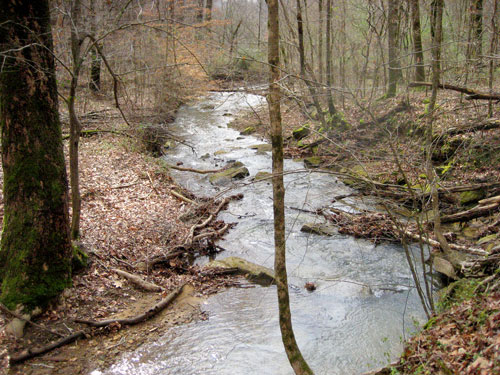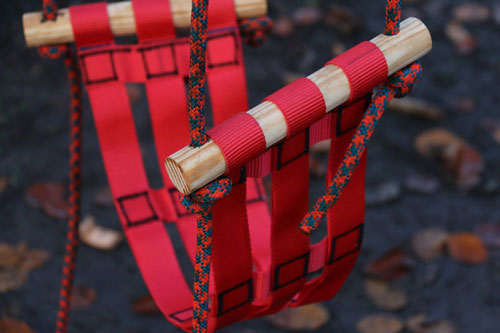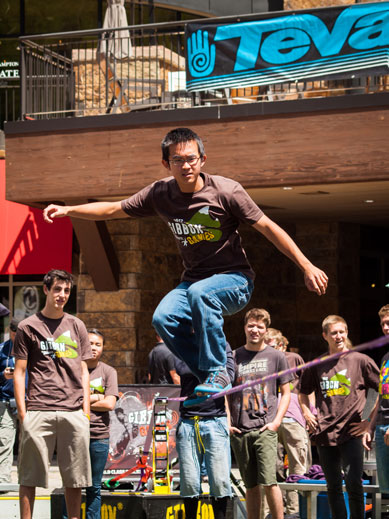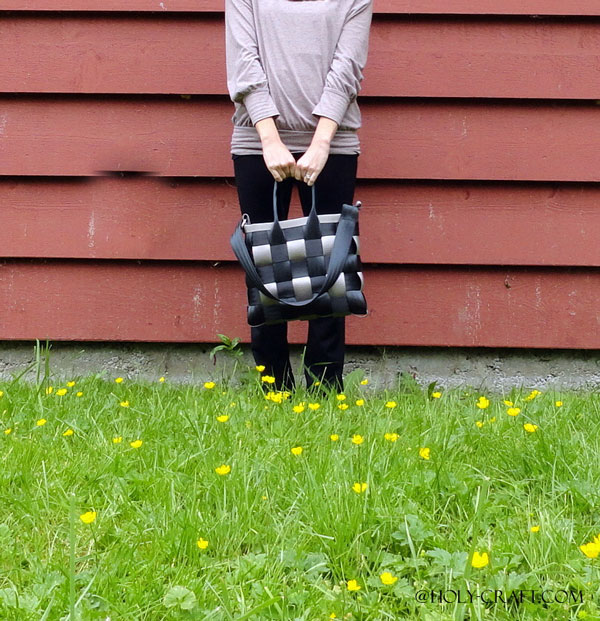The Ins of Using Webbing Outdoors

As a lifelong Southerner, I am convinced there might be a grand total of four weeks a year where "outside" is just about perfect. Unfortunately, these +/- 28 days are rarely closely linked to each other so I check the weather forecast. Daily, sometimes hourly. There's a saying in these parts, "If you don't like the weather, stick around for a few days … it'll change!"
Fortunately, I live in a region that has definite seasons and abundant natural resources. The Bankhead National Forest is a short 15 minute drive from my house. I can easily satisfy my need to breathe fresh air and clamber over roots and rocks when I get the urge to get outdoors.
I can't remember the first time I saw a piece of webbing being used. Probably as cotton tie-downs for our tent because we did a lot of camping when I was a child. I didn't own a backpack until college and it was certainly not the version today's students use. I'm not even sure it had an outside pocket, much less side-release buckles, snap hooks, elastic cording, waist straps, or multi-tiered loops for attaching things with carabiners. I am positive the straps were NOT padded!
The mountains are calling and I must go.
Later on, as my three boys grew into Boy Scouts and eventually Eagle Scouts, I saw a lot more of this vital piece of equipment. They used it for a quick clothesline (fastening 2-3 together, then looping around a tree trunk with a magical knot I could never master.) It was vital as a suspension system to keep bugs or even bears from rummaging through their trail pack. Securing drypacks in a canoe or kayak was a valuable lesson as well. Being prepared meant having a tie-down somewhere in your gear.
Take a closer look at flat webbing. It usually just sits around rolled up neatly or tossed in a pile. To be honest, I think it's something we all view as a one-trick pony. But when I started looking at what a piece of webbing strap can be instead of what it is, I discovered a skinny trampoline, a swing, a firewood tote, and even a purse!
Repair the Lawn Chairs
When the cold winds blow, nothing sounds better than a bowl of chili and reruns on Netflix. I find myself longing for the days when I can relax on the back patio in my favorite outdoor chaise lounge. That reminds me! The vinyl webbing on that chair was breaking last summer. I need to put that at the top of my husband's to-do list. I think I'll use polypropylene webbing straps to replace the broken ones.
That's an easy enough project and a lot cheaper than finding a new favorite chair or replacing the entire set. Polyproplene, or "polypro" as the experts call it, is economical, durable, and strong. (It's also easy to let my fingers do the driving and order it online from where I'm sitting by the fire.)
I love all the colors, too. I might even get a little crazy with contrasting webbing so it will look intentional : ) or wrap the straps around the frame so they are twice as strong. That way, I can toss those dingy cushions this year. That's a quick patio update and I don't have to scrub the cushions ever again! I can use the money I save to buy some MORE plants for the patio! My husband might not be eager to dig yet another new flower bed for me but I'll think about that after I place my order with the nursery.
To and Fro with Webbing
Dreaming of the lazy days of summer stirs up memories of small children playing outside for as long as possible. If there is a child in your life, make them a soft comfortable swing with flat and tubular webbing and dowels. A swing like this will brings (s)miles of joy whether you are the one watching, pushing, or swinging through the air with the greatest of ease.
Here's an easy to follow tutorial I found on Instructables for a fun swing. Isn't that a great looking swing? Happy kids, happy parents.
Webbing as a Fire Starter?
Well, webbing shouldn't be a flame starter per se. But to have a fire, you pretty much have to bring wood to the fireplace or the fire ring. So, start the process with an improvised carrying system.
Do what you can, with what you have, where you are.
Occasionally, I've had to bring in firewood by myself. It's hard for me to carry much more than 2-3 smaller pieces in my arms and still be able to open the door. Of course, I always seem to get dirty in the process. I'm sorta lazy and when it's cold enough for a fire -- I don't want to keep traipsing out to the woodpile! It occurred to me to borrow a tie-down or cargo strap from the stash in the garage and use it as an impromptu log carrier. Here's what I did:
- Fasten the strap's alligator clip to close the loop.
- Place the loop on the ground.
- Put several logs on the strap (perpendicular to the webbing.)
- Pick up the straps by what will become the handles.
- Pat yourself on the back for being so self-sufficient!
Tweet"Use a cargo strap as a do-it-yourself firewood carrier."
This would also be great idea for camping as well. You could probably snooker the kids into bringing wood in this way if you do it right. It was a lot of fun to see such amazement when I was sharing the idea so we could shoot the video. "That is so simple!" is the quote of the day for me.
In fact, you could probably carry just about anything this same way. I'm thinking mulch bags because they don't have handles and my wheelbarrow doesn't always fit where I need it to. If you use straps to lift, carry, or tote something, snap a quick picture and share it with us on Twitter @countrybrook.
Almost as Good as Joining the Circus
Is it just me or does every suburban backyard contain a trampoline? Eventually, the new wears off and the trampoline gets pushed to the back corner. Not even the dog will use it for shade anymore.
You will always be the cool family with the cool backyard if you have a slackline. It's stretchy and bouncy like a trampoline but won't kill the grass underneath and is a LOT more portable.
It's just what the sports doctor ordered for the entire family. The health benefits are impressive. Studies show that it even improves memory. (I might find myself trying to remember exactly why I thought it was a good idea … right before I fall with style.)
The dynamic nature of the line allows for tension adjustments -- tricks and stunts for the kiddos or just balance, posture, and core work for the adults. And you can load it in the car to take to grandma's house, the park, camping, or just about anywhere there are trees for anchoring. Entertain and educate yourself about slacklining on YouTube and then go for it!
Adding Holes to a Nylon Strap
Tools:
- Pliers, insulated is best
- Insulated gloves, if you don't have insulated pliers
- A nail or pin the size of the hole you want
- Cardboard to place under the strap
- A lighter or flame to heat the nail
Steps:
- Place the strap on the cardboard.
- Mark where you want the hole.
- Pick up the nail with the pliers.
- Heat the nail in the flame.
- Pierce the webbing quickly and smoothly.
- Melt the edges of the hole to seal the webbing.
You'll be surprised how having extra holes on existing nylon or polypro webbing straps on watches, belts, and backpacks will make outdoor life easier. Tighten things, attach a carabiner, store some extra paracord or tubular webbing, or even create a temporary loop.
Snap hooks or split rings will increase what you can carry outside your pack. Put the strap through a D-ring or O-ring, fold it back on itself to align two holes. Insert a small piece of cording or spare swivel hook to give you the option for easy access items you might need without stopping to unpack. It's pretty simple!
Webbing Works Without You Doing the Work
To me the outdoors is what you must pass through in order to get from your apartment into a taxicab.
If webbing makes you think of spiders rather than something that can lead to a great adventure, keep reading. No matter your destination, you'll need something fashionable to hold your survival gear, i.e. a bottle of Evian®, combination sunscreen/moisturizer, cell phone and battery pack, nail polish or makeup for touch-ups, a low-calorie snack, novel from Oprah's book club, and perhaps some stain remover … just in case.
Take the seatbelts with you when you leave the car! Using this tutorial, you can make a knock-off Harvey seatbelt bag. Seatbelt webbing comes in dynamite colors that will be perfect for a beach bag, a baby bag, or even a game day bag for tailgating.
A Walk with a Friend is Twice as Nice
Did you know January is National Walk Your Pet Month? Personally, I think a warmer month might be more conducive to participation since most of the country is under a blanket during January.
There are many health benefits to having a pet that can accompany you outdoors. The obvious exception would be pet fish because of that whole fish out of water thing. However, birds, cats, bunnies, and of course, dogs can motivate you to go for a walk. The change of scenery and exercise will be good for both of you.
I’m an introvert… I love being by myself, love being outdoors, love taking a long walk with my dogs and looking at the trees, flowers, the sky.
Why not make a statement with your pet's leash and collar? Ribbon on webbing, patterned polyester or bright neons will set the tone for the dog park crowd and get your pup noticed. Do-it-yourselfers can design a collar for a four-legged friend with this great tutorial.
Reflective webbing is great for those early morning or late evening junkets around the block when commuters are returning home for the night.
If you are lucky enough to have more than one dog to walk, you've probably spent more than your fair share of time untangling leashes from your legs and theirs. Or unwinding from trees and utility poles. Life is just easier with a leash coupler.
I hope I've encouraged you to think of new ways to use webbing outdoors when the weather allows. This handy guide to webbing might help. If you've used a cargo strap or tie-down for something other than containing cargo or tying down a truckload of materials, please share it with us on Facebook, Twitter, or Pinterest.


 Photo Courtesy Arina P Habich / Shutterstock.com
Photo Courtesy Arina P Habich / Shutterstock.com

